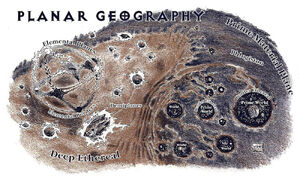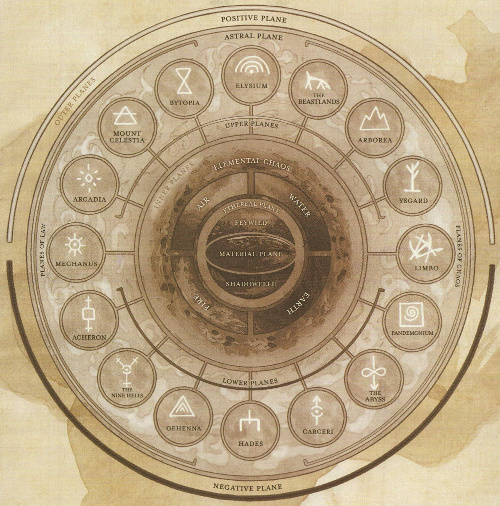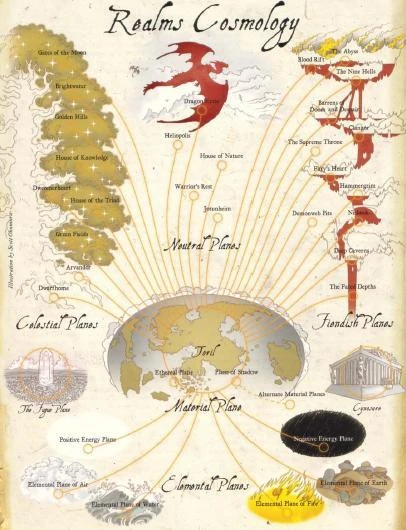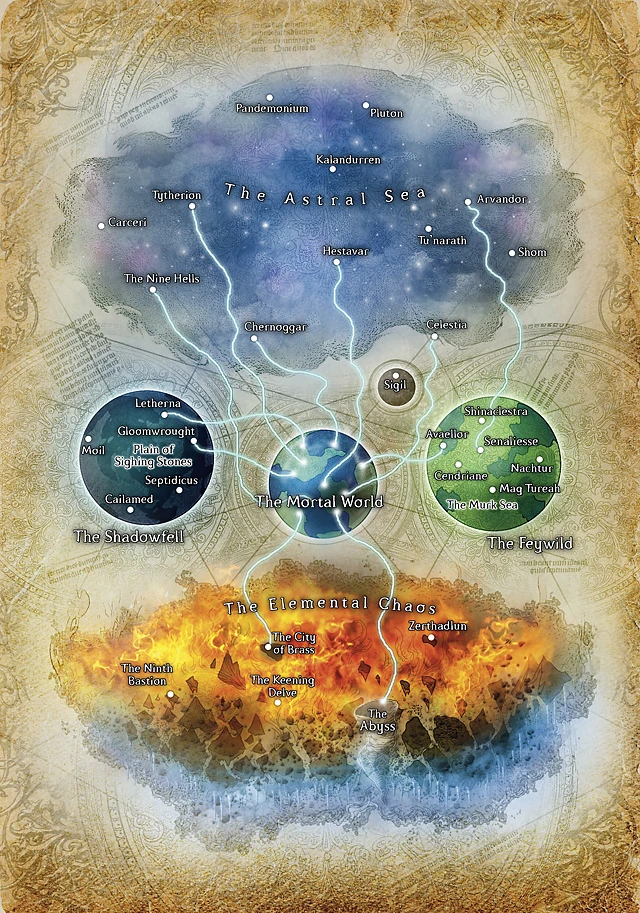The Ethereal plane was one of the planes of existence in various models of cosmology.
Geography[]
It is a place of ghosts and monsters.
It is right next to you, and you don't even see it.
Cosmology[]
Great Wheel[]
In the Great Wheel cosmology model, the Ethereal plane existed adjacent to the Prime Material Plane and connected it to the Inner planes (the Elemental planes plus the Energy planes). The Ethereal touched the Prime at all points that were located within crystal spheres through what was called the Border Ethereal. It was unknown whether the Border Ethereal touched the Prime in the phlogiston.[6][13]
The non-Border region was called the Deep Ethereal. While in the Border Ethereal, a traveler could still see into the adjacent plane but only dimly and not very far, whereas those on the bordering plane could not see the traveler without magical detection. Verbal communication was not possible between the Border Ethereal and the bordered plane. The Ethereal was unique among the many planes in that an individual could exist in two planes simultaneously: the Border Ethereal and the adjacent plane.[6]

A diagram representing the relative locations of the Border and Deep Ethereal, the Prime Material plane, and the Inner planes.
When travelers crossed into the Border Ethereal, they and all their possessions were converted to their Ethereal equivalents—metal became ethereal metal, flesh became ethereal flesh, and so on[14] —allowing free movement (in most cases) in any direction through the solid matter of the adjacent plane.[6] Since everything was permeated with ethereality, an air-breathing creature could breathe ethereal air and could not drown in an ethereal lake nor be crushed by an ethereal rock. However, not all in the adjacent plane was insubstantial. Living things larger than one-celled animals generated an aura that radiated around them and prevented passage to their interior, so an ethereal traveler could not place a weapon inside a living creature where it would materialize and cause damage. A jungle would be an extremely torturous maze to navigate; it would be much easier to float above the vegetation or pass below its roots. Dense metals such as lead or gold also prevented passage of ethereal matter. And finally, some magic spells and alchemical mixtures could form an effective barrier.[14]
Travel in the Ethereal and Border Ethereal was accomplished by force of will—you wished to go somewhere and you did, at your normal rate of movement. There was a sense of up and down but no real gravity existed. Objects released from possession would hover where they were dropped; it was impossible to fall in the Ethereal plane.[15] To get to another plane, one had to pass through a curtain of vaporous color into the Deep Ethereal, then traverse that region until reaching the curtain that demarcated the Border Ethereal of the destination plane. Each Inner plane and demiplane had a curtain with a unique color. The Prime Material plane's curtain was turquoise.[14] If the (usually magical) ethereal effect wore off while a traveler was in the Deep Ethereal, he would immediately be forced through a random curtain at a random location in the Border Ethereal and deposited on the plane which it bordered.[15]
When you passed through a curtain into the Deep Ethereal, time slowed down to one tenth the rate it flowed in the Border Ethereal and the plane that it bordered. For every ten hours spent in the Deep Ethereal only one hour passed on the other side of the curtain. Metabolic and other natural processes slowed down also, so it did not feel like ten hours, when you crossed back through a curtain into a Border Ethereal you were only an hour older and an hour hungrier.[14]
The Deep Ethereal swirled with large blobs of protomatter (imagine a cosmic lava lamp) which could form a demiplane when a critical size was reached. Powerful wizards, technologists, or demigods could also bend the proto-matter to their will and create a demiplane.[16] These nascent planes might exhibit some of the characteristics of the Inner planes or the Prime, but with their own rules of gravity, material make-up, etc., and even support life. Most demiplanes eventually collapse into themselves and break up or merge with another Inner or Prime Material plane.[17]
World Tree[]
In the World Tree cosmology model, the concept of the Border Ethereal was dropped and the Ethereal Plane became one of the transitive planes that coexisted with the Prime Material Plane.[18] Like the Great Wheel version, ethereal creatures and travelers could see into the Prime, but not the other way around. Unlike the Great Wheel version, you could pass through all solid objects, including living creatures, and you could hear the Material plane.[19]
The Ethereal Plane was mainly accessed by spells such as blink, etherealness, and ethereal jaunt. A phase door spell could be used to create a passage through the Ethereal, and Leomund's secret chest could temporarily stash a container in the Ethereal.[20]
The Ethereal Plane had the following traits in the World Tree cosmology model:[note 1]
- No Gravity: but with a definite "down" direction. Travelers could move along surfaces just as if they were on the Prime Material Plane but could also move in any direction by willing it so.
- Normal Time: same as the Material Plane.
- Alterable Morphic: if you can find anything to alter.
- Mildly Neutral-Aligned: no circumstance penalties.
- Normal Magic: spells and abilities worked as usual but could not affect the Material Plane.
Certain creatures dwelled primarily on the Ethereal Plane or could shift between it and the Material Plane virtually at will. Examples of these include ghosts,[21] ethereal marauders,[22] thought eaters,[23][24] thought slayers,[24] and phase spiders.[25]
Inhabitants[]
- Ethereal Filchers
- Ptah, god of creation and creativity, did not keep a permanent realm, but wandered the Ethereal Plane.[26][27]
- Phase Spiders inhabited the Ethereal Plane, "phasing" into the Prime Material Plane to hunt for prey.
Appendix[]
Notes[]
- ↑ The Player's Guide to Faerûn, page 142, states that Toril's Ethereal Plane is identical to the description given in the Dungeon Master's Guide v.3.5, so that source should be considered canon for this plane unless contradicted by a Forgotten Realms source.
Further Reading[]
- Bruce R. Cordell (1998). A Guide to the Ethereal Plane. Edited by Michele Carter, Keith Francis Strohm. (TSR, Inc.). ISBN 0-7869-1205-7.
External Links[]
 The Ethereal Plane article at the Eberron Wiki, a wiki for the Eberron campaign setting.
The Ethereal Plane article at the Eberron Wiki, a wiki for the Eberron campaign setting.
References[]
- ↑ Jeff Grubb, Bruce R. Cordell, David Noonan (September 2001). Manual of the Planes 3rd edition. (Wizards of the Coast). ISBN 0-7869-1850-8.
- ↑ Jeff Grubb (April 1987). “Plane Speaking: Tuning in to the Outer Planes”. In Roger E. Moore ed. Dragon #120 (TSR, Inc.), pp. 42–43.
- ↑ Jeff Grubb (July 1987). Manual of the Planes 1st edition. (TSR), p. 62. ISBN 0880383992.
- ↑ Jeff Grubb, Bruce R. Cordell, David Noonan (September 2001). Manual of the Planes 3rd edition. (Wizards of the Coast), p. 49. ISBN 0-7869-1850-8.
- ↑ Mike Mearls, Jeremy Crawford, Christopher Perkins, James Wyatt (2014). Dungeon Master's Guide 5th edition. (Wizards of the Coast), p. 47. ISBN 978-0786965622.
- ↑ 6.0 6.1 6.2 6.3 Jeff Grubb (July 1987). Manual of the Planes 1st edition. (TSR), p. 11. ISBN 0880383992.
- ↑ Jeff Grubb (July 1987). Manual of the Planes 1st edition. (TSR), pp. 18–20. ISBN 0880383992.
- ↑ Monte Cook, Jonathan Tweet, Skip Williams (July 2003). Dungeon Master's Guide v.3.5. (Wizards of the Coast), p. 147. ISBN 0-7869-2889-1.
- ↑ Monte Cook, Jonathan Tweet, Skip Williams (July 2003). Dungeon Master's Guide v.3.5. (Wizards of the Coast), p. 148. ISBN 0-7869-2889-1.
- ↑ Monte Cook, Jonathan Tweet, Skip Williams (July 2003). Dungeon Master's Guide v.3.5. (Wizards of the Coast), p. 151. ISBN 0-7869-2889-1.
- ↑ 11.0 11.1 Jeff Grubb, Bruce R. Cordell, David Noonan (September 2001). Manual of the Planes 3rd edition. (Wizards of the Coast), p. 53. ISBN 0-7869-1850-8.
- ↑ Jeff Grubb, Bruce R. Cordell, David Noonan (September 2001). Manual of the Planes 3rd edition. (Wizards of the Coast), p. 54. ISBN 0-7869-1850-8.
- ↑ Bruce R. Cordell (1998). A Guide to the Ethereal Plane. Edited by Michele Carter, Keith Francis Strohm. (TSR, Inc.), pp. 7–8. ISBN 0-7869-1205-7.
- ↑ 14.0 14.1 14.2 14.3 Jeff Grubb (July 1987). Manual of the Planes 1st edition. (TSR), p. 12. ISBN 0880383992.
- ↑ 15.0 15.1 Jeff Grubb (July 1987). Manual of the Planes 1st edition. (TSR), p. 13. ISBN 0880383992.
- ↑ David "Zeb" Cook (1989). Dungeon Master's Guide 2nd edition. (TSR, Inc.), p. 132. ISBN 0-88038-729-7.
- ↑ Jeff Grubb (July 1987). Manual of the Planes 1st edition. (TSR), p. 21. ISBN 0880383992.
- ↑ Ed Greenwood, Sean K. Reynolds, Skip Williams, Rob Heinsoo (June 2001). Forgotten Realms Campaign Setting 3rd edition. (Wizards of the Coast), p. 256. ISBN 0-7869-1836-5.
- ↑ Jonathan Tweet, Monte Cook, Skip Williams (July 2003). Player's Handbook v.3.5. (Wizards of the Coast), p. 206. ISBN 0-7869-2886-7.
- ↑ Jonathan Tweet, Monte Cook, Skip Williams (July 2003). Player's Handbook v.3.5. (Wizards of the Coast), pp. 206, 227, 228, 247. ISBN 0-7869-2886-7.
- ↑ Skip Williams, Jonathan Tweet, Monte Cook (July 2003). Monster Manual v.3.5. (Wizards of the Coast), pp. 116–118. ISBN 0-7869-2893-X.
- ↑ Skip Williams, Jonathan Tweet, Monte Cook (July 2003). Monster Manual v.3.5. (Wizards of the Coast), p. 105. ISBN 0-7869-2893-X.
- ↑ Bruce R. Cordell (1998). A Guide to the Ethereal Plane. Edited by Michele Carter, Keith Francis Strohm. (TSR, Inc.), p. 72. ISBN 0-7869-1205-7.
- ↑ 24.0 24.1 Bruce R. Cordell (April 2004). Expanded Psionics Handbook. (Wizards of the Coast), pp. 211–213. ISBN 0-7869-3301-1.
- ↑ Skip Williams, Jonathan Tweet, Monte Cook (July 2003). Monster Manual v.3.5. (Wizards of the Coast), pp. 207–208. ISBN 0-7869-2893-X.
- ↑ Bruce R. Cordell (1998). A Guide to the Ethereal Plane. Edited by Michele Carter, Keith Francis Strohm. (TSR, Inc.), p. 57. ISBN 0-7869-1205-7.
- ↑ Colin McComb (October 1996). On Hallowed Ground. Edited by Ray Vallese. (TSR, Inc.), p. 90. ISBN 0-7869-0430-5.
Connections[]

Prime Material plane • Feywild • Shadowfell • Fugue Plane
Transitive Planes: Astral Plane • Ethereal plane
Inner Planes: Elemental Plane of Air • Elemental Plane of Water • Elemental Plane of Earth • Elemental Plane of Fire • Elemental Chaos
Para-Elemental Planes: Frostfell • Swamp of Oblivion • Fountains of Creation • Great Conflagration
Quasi-Elemental Planes: Lightning • Radiance • Minerals • Steam • Vacuum • Ash • Dust • Salt
Outlands: Sigil
Outer Planes: Arcadia • Mount Celestia • Bytopia • Elysium • Beastlands • Arborea • Ysgard • Limbo •
Pandemonium • Abyss (Layers) • Carceri • Hades • Gehenna • Nine Hells • Acheron • Mechanus
Energy planes: Positive Energy plane • Negative Energy plane
Planar Pathways: Infinite Staircase • Oceanus • Mount Olympus • Styx • Yggdrasil
Far Realm

Prime Material plane • Cynosure • Fugue Plane
Transitive Planes: Astral Plane • Ethereal plane • Plane of Shadow • Spirit World
Celestial Outer Planes: Arvandor • Brightwater • Dwarfhome • Dweomerheart • Gates of the Moon • Golden Hills • Green Fields • House of Knowledge • House of the Triad
Fiendish Outer Planes: Abyss (Layers) • Barrens of Doom and Despair • Blood Rift • Clangor • Deep Caverns • Demonweb Pits • Fated Depths • Fury's Heart • Hammergrim • Nine Hells • Nishrek • Supreme Throne
Neutral Outer Planes: Dragon Eyrie • Heliopolis • House of Nature • Jotunheim • Warrior's Rest
Inner Planes: Elemental Plane of Air • Elemental Plane of Earth • Elemental Plane of Fire • Elemental Plane of Water • Positive Energy plane • Negative Energy plane
Planar Pathways: Infinite Staircase • River of Blood • World Tree
Far Realm

Prime Material plane
Fundamental planes: Astral Sea • Elemental Chaos
Astral dominions: Arvandor • Banehold • Celestia • Cynosure • Deep Wilds • Demonweb Pits • Dismal Caverns • Dwarfhome • Eternal Sun • Fugue Plane • Gates of the Moon • Green Fields • House of Knowledge • Nine Hells • Nishrek • Supreme Throne • Towers of Night • Tu'narath • Warrior's Rest
Elemental realms: Abyss (Layers) • City of Brass • Cresting Spires • Fimbulwinter • Hidden Realm • Muspelheim • Root Hold • Sky Home • Steading • Thraotor • Undying Pyre • Zerthadlun
Parallel planes: Feywild • Shadowfell
Anomalous planes: Far Realm
